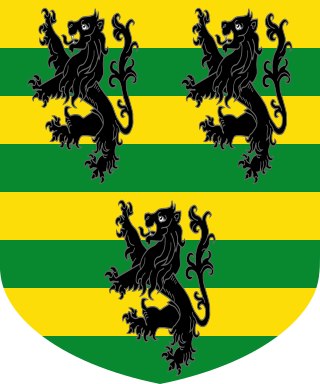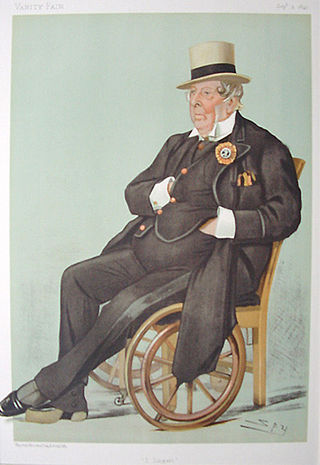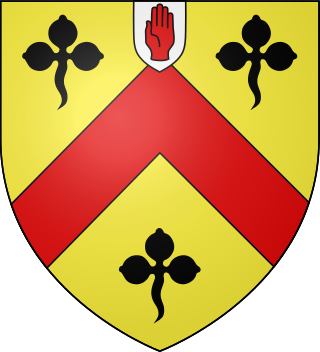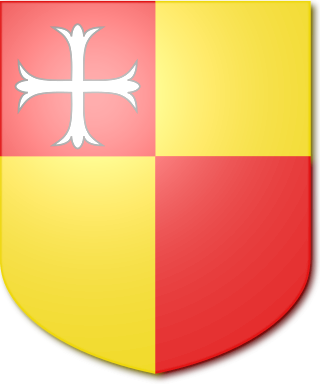This is a list of the high sheriffs of the English county of Northumberland. The high sheriff is the oldest secular office under the Crown. Formerly the High Sheriff was the principal law enforcement officer in the county but over the centuries most of the responsibilities associated with the post have been transferred elsewhere or are now defunct, so that its functions are now largely ceremonial. The High Sheriff changes every March.

The Sitwell Baronetcy, of Renishaw in the County of Derby, is a title in the Baronetage of the United Kingdom. It was created on 3 October 1808 for Sitwell Sitwell, Member of Parliament for West Looe. The Sitwell family had been ironmasters and landowners in Eckington, Derbyshire, for many centuries.

The Bunbury Baronetcy, of Bunbury, Oxon and Stanney Hall in the County of Chester, is a title in the Baronetage of England. It was created on 29 June 1681 for Thomas Bunbury, Sheriff of Cheshire from 1673 to 1674 and the member of an ancient Cheshire family. His grandson, Henry, the third Baronet, and great-grandson, the fourth Baronet, both sat as Members of Parliament for Chester. The latter died unmarried at an early age and was succeeded by his younger brother, the fifth Baronet. He was a clergyman. On his death in 1764 the title passed to his eldest son, the sixth Baronet. He represented Suffolk in the House of Commons for over forty years but is best remembered for his marriage to Lady Sarah Lennox. He died childless in 1821 and was succeeded by his nephew, the seventh Baronet. He was the son of Henry Bunbury, younger son of the fifth Baronet. The seventh Baronet was a distinguished soldier and politician. His eldest son, the eighth Baronet, was High Sheriff of Suffolk in 1868, and Fellow of the Royal Society. He died childless in 1886 and was succeeded by his younger brother, the ninth Baronet. He was Liberal Member of Parliament for Bury St Edmunds. He died unmarried in 1895 and was succeeded by his nephew, the tenth Baronet. He was the son of Colonel Henry William St Pierre Bunbury, third son of the seventh Baronet. He served as High Sheriff of Suffolk in 1908 and was a Deputy Lieutenant of the county. On his death in 1930 the title passed to his son, the eleventh Baronet. He was High Sheriff of Suffolk in 1936 and was a Deputy Lieutenant of the county. His son, the twelfth Baronet, was High Sheriff of Suffolk in 1972. As of 2014 the title was held by the latter's second but eldest surviving son, the thirteenth Baronet, who succeeded in 1985.

The Cradock-Hartopp Baronetcy, of Freathby in the County of Leicester and of Four Oaks Hall in the County of Warwick, was a title in the Baronetage of Great Britain. It was created on 12 May 1796 for Edmund Cradock-Hartopp, Member of Parliament for Leicestershire. Born Edmund Bunney, he was the husband of Anne Hurlock, granddaughter and heiress of Sir John Hartopp, 4th Baronet, of Freathby. On his marriage in 1777 he assumed the surname of Cradock-Hartopp in lieu of his patronymic according to the wills of his uncle Joseph Cradock and his wife's grandfather. His eldest surviving son Edmund, the second Baronet, died childless and was succeeded by his younger brother, William, the third Baronet. The title then descended from father to son until the death of his grandson, Charles, the fifth Baronet, in 1929.

Sir Charles Miles Lambert Monck, 6th Baronet was an English politician. He succeeded to the Baronetcy of Belsay Castle on the death of his father in 1795.

The Smith, later Smyth, Smijth, Bowyer-Smijth and Bowyer-Smyth Baronetcy, of Hill Hall in the County of Essex, was created on 28 November 1661 for Thomas Smith. The current holder is the fifteenth Baronet.
Sir John Fenwick, 1st Baronet of Wallington and Fenwick, Northumberland, was an English landowner and politician who sat in the House of Commons at various times between 1624 and 1648. He supported the Parliamentary cause in the Civil War.

The Blennerhassett Baronetcy of Blennerville in the County of Kerry, is a title in the Baronetage of the United Kingdom. It was created on 22 September 1809 for the Anglo-Irish lawyer Rowland Blennerhassett, He was from a family originally from Cumberland, England, that settled in County Kerry during the reign of James I and represented County Kerry and Tralee in the Irish House of Commons.

The Chance Baronetcy, of Grand Avenue in the parish of Hove in the County of Sussex, is a title in the Baronetage of the United Kingdom. It was created on 19 June 1900 for James Timmins Chance, a grandson of William Chance, one of the Chance brothers who started the family business in 1771. He became head of Chance Brothers and Company. He was High Sheriff of Staffordshire in 1868.

The Ricketts Baronetcy, of The Elms in the county of Gloucester and Beaumont Leys in the county of Leicester, is a title in the Baronetage of the United Kingdom. It was created on 15 February 1828 for Vice-Admiral Robert Ricketts.

Pennyman baronets are holders of one of two baronetcies created for members of the Pennyman family.

The Fletcher, later Boughey Baronetcy, of Newcastle-under-Lyme and of Betley both in the County of Stafford, is a title in the Baronetage of Great Britain. It was created on 24 August 1798 for Thomas Fletcher, of Betley Court, Staffordshire, High Sheriff of Staffordshire in 1783 and 1789 and Deputy Lieutenant of the county. He was the husband of Elizabeth Fenton, granddaughter of George Boughey, of Audley, Staffordshire whose will provided for his great-grandson to inherit the Audley estate.

The Smith, later Smith-Marriott Baronetcy, of Sydling St Nicholas in the County of Dorset, is a title in the Baronetage of Great Britain. It was created on 1 June 1774 for John Smith, High Sheriff of Dorset in 1772. The second Baronet married Elizabeth Anne, daughter of Reverend James Marriott. The fourth Baronet assumed by Royal sign-manual the additional surname of Marriott. The fifth Baronet was High Sheriff of Dorset in 1873.

Kirkharle is a village and former civil parish, now in the parish of Kirkwhelpington, in the county of Northumberland in Northern England located about 12 miles (19 km) west of the town of Morpeth, just to the west of the crossroads of the A696 and B6342 roads. It is famous as the birthplace of Lancelot 'Capability' Brown in the early eighteenth century, Britain's most celebrated landscape gardener. In 1951 the parish had a population of 69.

Sir Percy Lyham Loraine, 12th Baronet, was a British diplomat. He was British High Commissioner to Egypt from 1929 to 1933, British Ambassador to Turkey from 1933 to 1939 and British Ambassador to Italy from 1939 to 1940. In later life he was involved in breeding thoroughbreds for horse racing and won the 2000 Guineas Stakes in 1954 with Darius. He was the last of the Loraine baronets, having no sons to succeed him.

John Loraine Baldwin was an English cricket enthusiast who was a co-founder of the I Zingari nomadic cricket club.

Sir Lambton Loraine, 11th Baronet was a British naval officer, involved in several incidents of gunboat diplomacy. He is best remembered for his involvement in the "Virginius Affair" of 1873.

The Abdy Baronetcy, of Albyns, in the County of Essex, was created in the Baronetage of the United Kingdom on 22 December 1849 for Thomas Neville Abdy who sat for Lyme Regis in the British House of Commons. It was a second creation for the seat: see Abdy baronets of Albyns (1660).

The Middleton Baronetcy, of Belsay Castle in the County of Northumberland, was created in the Baronetage of England on 24 October 1662 for William Middleton, of Belsay Castle, Belsay, Northumberland. The Middletons were descended from Richard Middleton who was Lord Chancellor to Henry III. His grandson Sir Gilbert Middleton took part in a rebellion against Edward II. He was captured and executed. The Middleton estates including Belsay were forfeited to the Crown but were restored to the family by marriage in the reign of Edward III. Sir John Middleton was a fervent Yorkist in the 15th century and fought at the Battles of St Albans in 1455 and Bosworth in 1485. The third, fifth and sixth Baronets all sat as Member of Parliament for Northumberland. The sixth Baronet assumed in 1799 by Royal sign-manual the surname of Monck in lieu of his patronymic, according to the will of his maternal grandfather Lawrence Monck. The seventh Baronet, who represented Durham in Parliament, resumed the use of the surname of Middleton.
The Preston baronetcy, of Beeston St Lawrence in the County of Norfolk, was created in the Baronetage of the United Kingdom on 30 May 1815 for Thomas Hulton Preston. Born Thomas Hulton, he was the son of Henry Hulton and his wife Elizabeth, daughter of Isaac Preston of Beeston St Lawrence, whose estates he inherited. In 1804 he assumed the surname of Preston in lieu of his patronymic. He was a militia colonel in the Norfolk volunteer infantry.


















